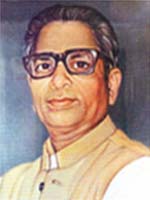Pandit Deendayal Upadhyay
(1916 – 1968)

Pandit Deendayal Upadhyay, an extraordinary visionary and one of the pioneers of the nationalist school of thought, had conceived the idea of an academy for socio-political activists. However, Pandit Deendayal Upadhyay passed away before he could translate his vision into reality. After the abrupt and unfortunate departure of Panditji, Rambhau Mhalgi, a prominent political figure from Maharashtra, made it his responsibility to materialise his idea.
This is how a concept propounded by two eminent thinkers and activists came into existence in the form of Rambhau Mhalgi Prabodhini (RMP). Initially launched as a memorial of Late Rambhau Mhalgi, in 1982, RMP widened its scope to be established as a unique training and research academy, primarily aimed at enhancing the capabilities of voluntary activists and elected representatives of the people. Over the years it has blossomed into a multi-dimensional institute imparting training to elected representatives, activists, civil servants and journalists, and a centre for overall public-awakening activities and research projects. Additionally, the institute also provides training facilities, and accommodation and recreation facilities to corporate houses.

Rambhau Mhalgi
(1921-1982)
RMP focuses on developing the human capital and management capabilities with the backdrop of age-old Indian values, and gets its inspiration from Late Rambhau Mhalgi, former Member of Indian Parliament and an outstanding representative of the people. As we know, the success of democracy depends on the dedication and efficiency of elected representatives.
Ramchandra Mhalgi (later called Rambhau) was born on 9th July 1921 in a well-established agricultural family from Pune District in Maharashtra. The fourth child of Kashinathpant and Sarasvatibai, Ramchandra lost his mother at the age of 11 years. After passing the vernacular final exam in school, he joined the Sarasvati Mandir School in Pune and passed 3 grades in one academic year, and cleared the matriculation exam with first division in 1939. Ramchandra’s contact with Rashtriya Swayamsevak Sangh (RSS) dates back to his school days. After matriculation, instead of staying back for further studies, he went to Kerala, as ‘Rambhau’ an RSS Pracharak (full-time social worker). Later, he returned to Pune for graduation; but responding to the wish of the second RSS Chief (Sarsanghchalak) – Golwalkar Guruji, he joined RSS.
When RSS was banned in 1948, Rambhau went underground and continued the movement against injustice. After the ban was lifted, he went back to Pune, where he bagged both the degrees of LLB and MA and cleared the bar council exam. He was entrusted with the responsibility of Akhil Bharatiya Vidyarthi Parishad (ABVP), the student wing of RSS, and later that of Jan Sangh (the then political wing of RSS). He took up the responsibility as executive officer of the party in Maharashtra. With his leadership, creativity and practicality, he set up various fronts, trying to reach out to people from different walks of life. He helped create awareness about the complete merger of Jammu and Kashmir with India. While the party kept growing, he got married to a teacher – Manu Ghanekar. He beautifully balanced his personal, professional and political life.

